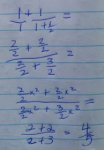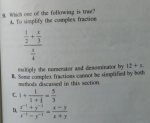allegansveritatem
Full Member
- Joined
- Jan 10, 2018
- Messages
- 962
Here is one of the choices in a multiple choice problem whose question is: Which of the following is true? This is choice C:
. . . . .\(\displaystyle \mbox{C. }\, 1\, +\, \dfrac{1}{1\, +\, \frac{1}{2}}\, =\, \dfrac{5}{3}\)
I tried all the other choices and they all seemed to be false. But I don't seem to be able to come up with (5)/(3) when I do the preoblem. Here is what I did:

I spent quite a lot of time on this and did it several ways and in one of the attempts I did come up with (5)/(3), but I finally settled on the answer that is in the image above. Am I wrong or is one of the other choices right and I am wrong in rejecting them? I will see if I can find a photo of the whole problem and I will upload it below if I can find it.
I found it! Here is the whole thing:

. . . . .\(\displaystyle \mbox{C. }\, 1\, +\, \dfrac{1}{1\, +\, \frac{1}{2}}\, =\, \dfrac{5}{3}\)
I tried all the other choices and they all seemed to be false. But I don't seem to be able to come up with (5)/(3) when I do the preoblem. Here is what I did:

I spent quite a lot of time on this and did it several ways and in one of the attempts I did come up with (5)/(3), but I finally settled on the answer that is in the image above. Am I wrong or is one of the other choices right and I am wrong in rejecting them? I will see if I can find a photo of the whole problem and I will upload it below if I can find it.
I found it! Here is the whole thing:

Attachments
Last edited by a moderator:

